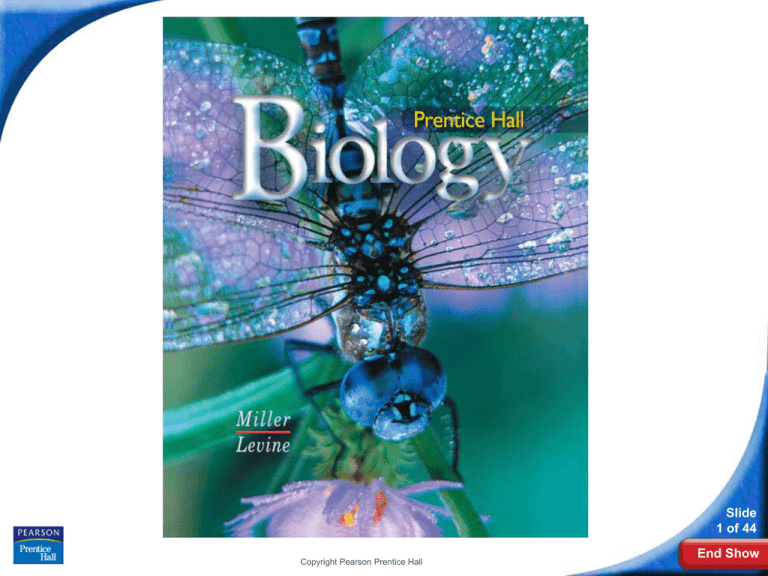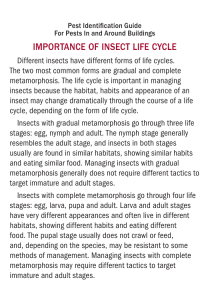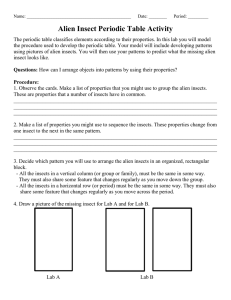
Biology
Slide
1 of 44
Copyright Pearson Prentice Hall
End Show
28–3 Insects
Slide
2 of 44
Copyright Pearson Prentice Hall
End Show
28–3 Insects
Insects
Class Insecta contains more species than any other
group of animals.
Slide
3 of 44
Copyright Pearson Prentice Hall
End Show
28–3 Insects
What Is an Insect?
Unlike spiders who have
two body parts
What Is an Insect?
Insects have a body divided into three
parts—head, thorax, and abdomen. Three
pairs of legs are attached to the thorax.
Head
Thorax
Abdomen
Slide
4 of 44
Copyright Pearson Prentice Hall
End Show
28–3 Insects
What Is an Insect?
Insects have a segmented body, an exoskeleton,
and jointed appendages.
A typical insect also has:
•
•
•
a pair of antennae
a pair of compound eyes
two pairs of wings on the thorax
Slide
5 of 44
Copyright Pearson Prentice Hall
End Show
28–3 Insects
What Is an Insect?
Responses to Stimuli
Compound eyes made up of many lenses detect
minute changes in color and movement.
The brain assembles information from the eye and
directs the insect’s response.
Slide
6 of 44
Copyright Pearson Prentice Hall
End Show
28–3 Insects
What Is an Insect?
Adaptations for Feeding
Insects have three pairs of appendages that are
used as mouthparts, including a pair of mandibles.
Insect mouthparts are specialized for feeding.
Slide
7 of 44
Copyright Pearson Prentice Hall
End Show
28–3 Insects
What Is an Insect?
Specialized Mouthparts
Mandibles used to
saw and grind food
Ant
Copyright Pearson Prentice Hall
Slide
8 of 44
End Show
28–3 Insects
What Is an Insect?
Specialized Mouthparts
Tubelike mouthpart
used to suck nectar
Moth
Copyright Pearson Prentice Hall
Slide
9 of 44
End Show
28–3 Insects
What Is an Insect?
Specialized Mouthparts
Spongelike mouthpart
used to lap up food
Fly
Copyright Pearson Prentice Hall
Slide
10 of 44
End Show
28–3 Insects
What Is an Insect?
Movement and Flight
Insects have three pairs of legs, which are used
for walking, jumping, or capturing and holding
prey.
Slide
11 of 44
Copyright Pearson Prentice Hall
End Show
28–3 Insects
What Is an Insect?
Flying insects typically have two pairs of wings
made of chitin.
Flight has allowed insects to disperse long distances
and to colonize a wide variety of habitats.
Slide
12 of 44
Copyright Pearson Prentice Hall
End Show
28–3 Insects
What Is an Insect?
Metamorphosis
The growth and development of insects
usually involves metamorphosis, which is a
process of changing shape and form.
Insects undergo either incomplete
metamorphosis or complete metamorphosis.
Slide
13 of 44
Copyright Pearson Prentice Hall
End Show
28–3 Insects
What Is an Insect?
Immature insects that undergo incomplete
metamorphosis look very much like the adults.
These immature forms are called nymphs.
Slide
14 of 44
Copyright Pearson Prentice Hall
End Show
28–3 Insects
What Is an Insect?
Adult
Adult
Eggs
Incomplete
Metamorphosis
Nymph
Nymph
Nymph
Copyright Pearson Prentice Hall
Slide
15 of 44
End Show
28–3 Insects
What Is an Insect?
In complete metamorphosis, animals hatch into
larvae that look and act nothing like their parents.
They feed and grow rapidly and molt a few times.
They undergo a final molt and change into a pupa—
the stage in which an insect changes from larva to
adult.
Slide
16 of 44
Copyright Pearson Prentice Hall
End Show
28–3 Insects
What Is an Insect?
pupa
Adult
Eggs
Complete
metamorphosis
Adult
Larva
Larva
Pupa
Copyright Pearson Prentice Hall
Slide
17 of 44
End Show
28–3 Insects
Insect Communication
Insect Communication
Insects communicate using sound, visual,
chemical, and other types of signals.
Much of their communication involves finding a
mate.
Slide
18 of 44
Copyright Pearson Prentice Hall
End Show
28–3 Insects
Insect Societies
Insect Societies
Ants, bees, termites, and some of their
relatives form complex associations
called societies.
A society is a group of closely related
animals of the same species that work
together for the benefit of the whole group.
Slide
19 of 44
Copyright Pearson Prentice Hall
End Show
28–3 Insects
Insect Societies
Communication in Societies
Each species of social insect use visual, touch,
sound, and chemical signals to communicate
information among members of the colony.
Honeybees communicate information about
food through a series of complex movements.
Slide
20 of 44
Copyright Pearson Prentice Hall
End Show
28–3 Insects
Insect Societies
The round dance
indicates that food
is fairly close to
the hive.
Slide
21 of 44
Copyright Pearson Prentice Hall
End Show
28–3 Insects
Insect Societies
The waggle
dance
indicates that
food is farther
away from the
hive. It also
indicates the
direction of the
food.
Slide
22 of 44
Copyright Pearson Prentice Hall
End Show
28–3
Click to Launch:
Continue to:
- or -
Slide
23 of 44
End Show
Copyright Pearson Prentice Hall
28–3
How many body parts do insects have?
a. two
b. three
c. four
d. five
Slide
24 of 44
End Show
Copyright Pearson Prentice Hall
28–3
Which group contains the most species?
a. vertebrates
b. nonvertebrate invertebrates
c. noninsect arthropods
d. insects
Slide
25 of 44
End Show
Copyright Pearson Prentice Hall
28–3
Characteristics shared by typical insects include
a. six walking legs and one pair of wings.
b. six walking legs and two pairs of wings.
c. eight walking legs and one pair of wings.
d. eight walking legs and two pairs of wings.
Slide
26 of 44
End Show
Copyright Pearson Prentice Hall
28–3
The immature form of an insect that undergoes
incomplete metamorphosis is called a(n)
a. larva.
b. nymph.
c. pupa.
d. embryo.
Slide
27 of 44
End Show
Copyright Pearson Prentice Hall
28–3
Which of the following species form complex
societies?
a. butterflies
b. ants
c. locusts
d. flies
Slide
28 of 44
End Show
Copyright Pearson Prentice Hall
END OF SECTION







